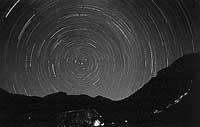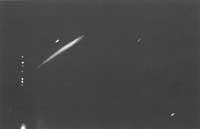Comets in computer vision
2001/07/29 Kortabarria Olabarria, Beñardo - Elhuyar Zientzia
What did you think? What was only Halley's work to find kites? XXI. Although in the 20th century there are still people looking for comets, we now have cyberobservers instead of directly using telescopes.

Exploring space without a telescope? Well, it is true that the above sentence is not entirely correct. But as it appears in an article in the magazine Astronomy of July, today computers are communicated with each other, and so you have at your disposal, reader, the possibility to analyze at home the data collected by the largest space telescopes in the world.
Curious? Imagine that instead of from the garden with your telescope you have at your disposal the best telescopes developed with the latest technology worldwide. 200 inch Palomar Telescope, Hubble Space Telescope or SOHO Project. This is what many astronomers have discovered.
Michel Oates is one of them. For fifteen years he toured the sky from his home in Manchester and always had the dream of finding a comet. And that dream came true. Now it drops daily more than 100 megabytes of data collected by SOHO (the Sun observer and the heliosphere) directly from your computer. It is a mission of 1.2 billion dollars (210 billion pounds/8.4 billion pounds) jointly developed by SOHO, ESA and NASA. The SOHO is an observation mission of the Sun, in which the three devices collect data from the interior of the Sun and five others study the atmosphere of the Sun using corographs.

Michael Oates has already found more than one hundred kites and still remembers June 6, 2000: that day he discovered 6 new kites. Michael Oates is amateur, receives no money for his discoveries and does not attend any congress. But for him his work is very rewarding and he also receives the recognition of the discovery.
SOHO cameras collect a series of fleeting kites that disappear as they approach the crown. Oates analyzes several images at once on your computer, allowing you to see the path of these comets until their disappearance.
And what is needed for this? There is nothing, it is enough to have the home computer and the modem, since the images of several telescopes around the world have been made available to anyone.
The news has also spread to institutes. David Colin had no knowledge of astronomy, but, with the help of the professor, in 1999 Rho Cassiopea began to study the supergiant variable from the data collected by the Association of American Variable Stars in 12 years. The student compared the data and analyzed the color and brightness changes of the star over time. Kolin's domestic tasks by the end of summer were unusual: The main pulsation cycle with a period of 820 days and secondary periods of 380, 510 and 645 days. In addition, as for the colors, being the star at its last position, it changes from yellow to red and from black to yellow. He now studies astronomy at the University of Colin Montreal.

The same happened to McCurdy, Gustafson and Peterson of California. To obtain points they enrolled in the course "Initiation to Astronomy". There, while studying how astronomical data is worked, they collected data from the Chilean Tololo Observation Centre. When analyzing the images, they found an object in motion. But the element found was far beyond the orbit of Neptune under study. Calculations were made and they realized that it was further than Pluto. Thus they discovered the first of the 100 known objects of the Kuiper belt.
Purpose of data exchange

The provision of the data has a clear reason. Many projects are advanced by research groups from different parts of the world. Although they are very interesting one by one, the real importance is acquired when you can exchange. Therefore, the Observatory for Virtual Observations (NVO) was born with the aim of making all this information available to scientists. Thus, a new way of doing astronomy in common with astronomers, physicists, etc. has been opened. international. At the end of the project, the world's main astronomical archives will be connected to each other and anyone can use this data if they have an Internet connection at home. The end of the project is still long, but meanwhile several databases are being completed.

SkyView is one of these databases. In 1994 he began offering images of the Hubble Space Telescope. Users choose a celestial point or object and SkyView provides the map of radio waves or gamma rays of the region. Using SkyView data, amateur cyberastronomers Gnaedig and Doppler have ensured that the asteroid AN10 does not hit the Earth until at least 2076. At least it has brought us tranquility.
As you can see, the option offered by cybertelescopes is not easy. Even better from domestic warmth, when the universe can be seen even when the sky is covered.
Published in 7K

Gai honi buruzko eduki gehiago
Elhuyarrek garatutako teknologia





